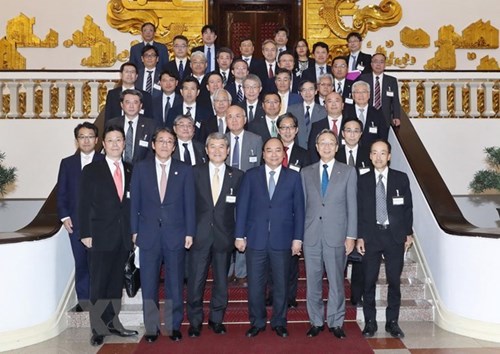Hosting a reception for two Keidanren Co-Chairs, Kuniharu Nakamura and Hideo Ichikawa Keidanren, and members of Keidanren delegation in Hanoi, PM Phuc stressed that the bilateral relations are developing in a more practical and effective manner based on the Extensive Strategic Partnership.
Japan is currently Vietnam’s second largest official development assistance (ODA) sponsor and second largest foreign investor, while also ranking third amongst tourism arrivals into the Vietnam, the PM said, expressing his hope that Keidanren will further its efforts to position Japan first in all those fields.
Lauding Japan’s role and coordination with Vietnam towards accelerating the signing of the Comprehensive and Progressive Agreement for Trans-Pacific Partnership (CPTPP), PM Phuc noted that Vietnam will adopt the pact by the end of this year, and hopes to accompany Japan in solidifying the deal.
    |
 |
|
PM Nguyen Xuan Phuc (front, third from right) and the Keidanren delegation pose for a photo |
Vietnam always considers the East Asian country as one of its leading partners, and hopes that both sides would bolster cooperation in various sectors for the sake of the two peoples, and for regional and global peace and prosperity, the government leader said.
The Vietnamese Government and people believe that Japanese businesses will preserve their prestige, and pour long-term, sustainable investment in the country. As both nations present huge potential for further collaboration, the Government will create favorable conditions for Japanese companies in the spirit of mutual benefit, he noted.
PM Phuc wished that the Japanese side will continue its support for Vietnam in the nation’s socio-economic development process, especially in the fields most in demand, such as agricultural machinery, oil and gas, automobile engineering, energy, processing and manufacturing, and infrastructure development.
Besides economy and trade collaboration, Vietnam wants to enhance people-to-people and cultural exchanges with Japan, he said, adding Vietnam backs Japan’s activities to promote cooperation in the framework of collaboration programs with the Mekong Sub-region countries.
PM Phuc proposed that the two Keidanren Co-Chairs and members of Keidanren delegation step up their implementation of the Vietnam-Japan Joint Initiative to maintain policy dialogue mechanisms between the Vietnamese Government agencies and Japanese enterprises. He described this effective channel for Vietnamese authorities to complete regulations and policies to better the business climate.
Expressing his delights over the growing Vietnam-Japan Extensive Strategic Partnership, Kuniharu Nakamura said that high-level visits have consolidated the friendship and comprehensive cooperation between the two countries.
As for Japanese firms, Vietnam is an attractive market due to its large population, stable socio-political environment, as well as its role of a gateway for Japan to tap into the ASEAN market.
Last year, Vietnam welcomed the largest amount of Japanese investment, with USD 9.1 billion in capital injected by over 1,700 businesses, he said, pledging to enhance investment in Vietnamese infrastructure and human resources.
For the time ahead, Keidanren will extend its granting of scholarships for Vietnamese students, he underlined.
Meanwhile, Hideo Ichikawa said that Keidanren also wants to help Vietnam improve its business climate through the implementation of the Vietnam-Japan Joint Initiative, which is now in its seventh phase.
He said he hopes to receive further support from the Vietnamese authorities in carrying out the initiative.
Laying stress on the significance of infrastructure development in the context of curbing the ceiling ratio of public debt, he suggested the Vietnamese Government choose rational projects under the public-private partnership (PPP) model, adding that Japanese firms stand ready to join such projects in Vietnam.
The Japan Business Federation is the largest economic organization in Japan with 1,340 companies, 109 industrial associations, and 49 regional economic organizations.
Source: VNA